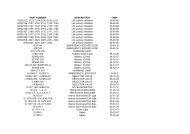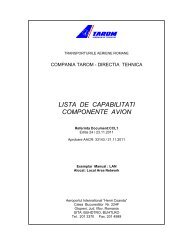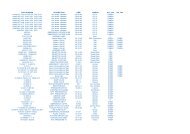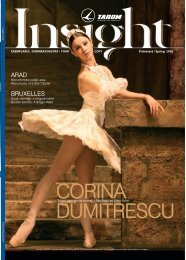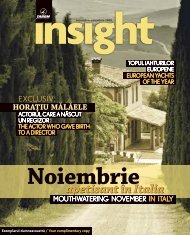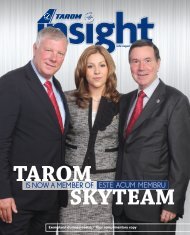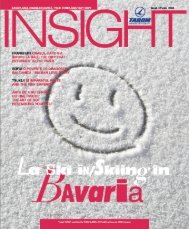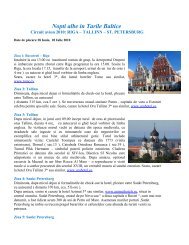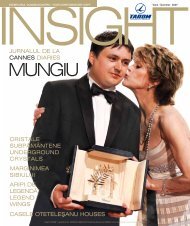Create successful ePaper yourself
Turn your PDF publications into a flip-book with our unique Google optimized e-Paper software.
ITINERARII Air Treks 10<br />
® nic\ - strada `n oglind\. Fiecare cas\ este identic\ celei de peste drum,<br />
de la structur\ [i form\ p‚n\ la detaliile arhitectonice, sculpturi ornamentale,<br />
por]i, grilajele ferestrelor [i balcoane.<br />
BASTIONUL CROITORILOR - MEMORIA ~NL|CRIMAT|<br />
~n centrul Pie]ei {tefan cel Mare se `nal]\ catedrala mitropolitan\,<br />
l\ca[ de cult ortodox zidit `n primii ani ai secolului XX, `n stil bizantin.<br />
Cupola bisericii a fost modelat\ dup\ cea a Hagiei Sofia.<br />
Pia]a marcheaz\ limita vechii cet\]i clujene. La c‚teva sute de metri se<br />
reg\se[te singurul fragment din zidul fortifica]iei, care a supravie]uit anilor,<br />
[i Bastionul Croitorilor, construit ca turn de observa]ie. ~n 5 februarie<br />
1601, edilii au expus aici trupul ne`nsufle]it al lui Baba Novac, c\pitanul<br />
lui Mihai Viteazul, ars de viu dup\ `nfr‚ngerea de la Mir\sl\u. Ast\zi, o<br />
statuie [i numele str\zii din apropiere amintesc de soarta nefericitului<br />
c\pitan. Un alt turn, cel al Pompierilor, se ridic\ solitar la c‚]iva kilometri<br />
distan]\, pe malul Some[ului. Fortifica]ia a ap\rut `n secolul al XV-lea [i<br />
proteja vechile ziduri ale cet\]ii, ridicate `n secolul al XIII-lea.<br />
Str\zile Baba Novac [i Mihail Kog\lniceanu ne readuc `ncet spre Pia]a<br />
Unirii, cu un popas la biserica reformat\, construit\ `n stil gotic t‚rziu `ntre<br />
1486 [i 1510, cu ajutorul b\nesc al lui Matei Corvin. Pe latura nordic\ pot fi<br />
v\zute `nc\ ghiulelele ce au p\truns `n zid `n timpul asediilor din secolele<br />
XVI [i XVII.<br />
Drumul trece pe l‚ng\ cl\direa Filarmonicii clujene, pe l‚ng\ impozanta<br />
cl\dire a Universit\]ii Babe[-Bolyai, [i duce pe Strada Universit\-<br />
]ii, la Biserica Piari[tilor, construit\ `ntre anii 1718 [i 1724, `ntr-un baroc<br />
fermec\tor.<br />
®<br />
Vitraliu / Stained glass window<br />
® citadel’s walls and the Tailors’<br />
Bastion, built by the tailors’ guild<br />
as an observation tower.<br />
On February 5, 1601, the city<br />
leaders displayed there the body<br />
of Baba Novac, a captain in the<br />
army of ruler Mihai the Brave,<br />
burned alive after the defeat at<br />
Miraslau.<br />
Today, a statue and the name<br />
of a nearby street are remembrances<br />
of the captain’s sad fate.<br />
Another tower, of the firefighters,<br />
stands solitary a few kilometers<br />
away, on the bank of the Somes<br />
River.<br />
It was built in the 15 th century<br />
to protect the old city walls, dating<br />
from the 13 th century.<br />
Baba Novac and Mihail Kogalniceanu<br />
streets bring the visitor<br />
back to Unirii Square, with a stop<br />
at the Protestant church built in a<br />
late Gothic style between 1486 and<br />
1510, with financial support from<br />
Matei Corvin. The unrest of the<br />
Reformation prevented people<br />
from entering there for ceremonies<br />
until 1579, when Prince Bathory<br />
gave it to the Jesuits. In 1662, the<br />
leaders’ council decided the<br />
church would be used by Protestants,<br />
who remain in charge of it,<br />
even today. The holes made by<br />
projectiles during sieges in the 16 th<br />
and 17 th<br />
centuries are still visible<br />
on the northern side.<br />
THE INN OF ROYAL<br />
TRAVELERS<br />
The road goes further along<br />
the building of the Cluj Philharmonic<br />
Orchestra, the imposing<br />
Babes-Bolyai University building<br />
and leads to University Street and<br />
the Piarist Church, built between<br />
1718 and 1724, in charming<br />
baroque.<br />
Crossing Unirii Square, the visitor<br />
can walk down Corvin Street<br />
to see Cluj’s oldest laic building:<br />
the Matei Corvin Memorial House,<br />
a gothic building dating back to<br />
the 14 th<br />
century. In spite of its<br />
name, the building did not belong<br />
to Corvin’s family. It was an inn<br />
where the king’s mother, Erzsebet<br />
Szilagyi, lived and where Matei<br />
Corvin was born and lived his first<br />
months.<br />
Museum Square got its name<br />
from the nearby Transylvanian<br />
History Museum. Set up in 1859<br />
by the Transylvanian Museum<br />
Society and functioning in the current<br />
headquarters since 1932, the<br />
institution presents a broad history<br />
of Transylvania.<br />
The collections include a lapidary<br />
with Roman and medieval<br />
engraved stones and a treasure of<br />
about 4,000 pieces of gold and silver<br />
jewelry, harnesses, clothing accessories,<br />
coins and medals.<br />
The Franciscan Church, ®



